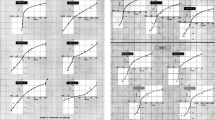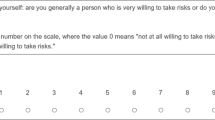Abstract
This experimental study uses a non-parametric method to investigate probability weighting functions for very low probabilities in the loss domain. Probability weights in three loss situations containing small, large and heterogeneous losses composed of both small and large losses are elicited. While most of the probabilities under consideration are significantly overweighted, the probability weighting function exhibits the much replicated inverse S-shaped functions when losses are small. Interestingly, the more common probabilities, 0.1 and 0.01, get underweighted by more than half of the sample in small and heterogeneous loss situations, respectively. Probability underweighting is accompanied by risk-loving behaviour that can have implications for design of contracts and policies designed to control risky behaviours.

Similar content being viewed by others
Notes
Etchart-Vincent (2009).
Fehr-Duda et al. (2006).
Froot (2001).
Hertwig et al. (2004).
Etchart-Vincent (2004).
Bar-Ilan and Sacerdote (2004).
Kousky and Cooke (2012).
Some other studies focused on estimating the sample utility and probability weighting function simultaneously by means of structural maximum likelihood. However, in this study because the focus was on very low probabilities and their sensitivity, it was required to elicit them separately.
Wakker and Deneffe (1996).
Abdellaoui et al. (2016)
Prelec (1998)
Goldstein and Einhorn (1987).
Fischbacher (2007).
Performance-based payment for losses was avoided as it is ethically wrong. Moreover, endowing subjects with potential losses might lead to house money effect which indicates increased risk-seeking behaviour in the presence of a prior gain (Thaler and Johnson 1990; Keasy and Moon 1996; Boylan and Sprinkle 2001). Finally, evidence suggests that financial incentives do not significantly change the results when the task is as simple as preferences over lotteries (Camerer and Hogarth 1999).
£60 corresponds to the minimum penalty for failing to stop at a red light and £5000 stands for the highest monetary fine.
Although the value of c can be any large enough arbitrary number, in order to get reliable indifference points, I took special care to fix all the feasible intervals. For this purpose, I found the value of \(c_{0}\) that makes the expected value of the two lotteries equal and ensured that c is considerably higher than this expected value.
Tverksy and Kahneman (1992).
Currim and Sarin (1989).
Following ANOVA analysis, using Fisher’s Least Significant Difference (LSD) test, I compared the mean of probability weights with a pooled standard deviation. While LSD tests indicated a significant space effect, the size effect was not significant.
Gonzalez and Wu (1999).
The estimated value of \(\alpha\) for the median of TO sequence (second row of Table 3 ) is 0.58.
Abdellaoui (2000).
Starmer and Sugden (1989).
Camerer (1989).
Reversed preferences refer to the case where subjects previously chose A over B and later chose B over A. This should not be confused with preference reversal indicating the possibility of context dependency of preferences.
The lowest probability point in the study of Etchart-Vincent (2009) is 0.01.
Fehr-Duda et al. (2010).
Hilbig and Glockner (2011).
Fennema and Van Assen (1999).
The determination of indifferent outcomes is through a successive choice procedure rather than directly asking the subject. Hence, the experimenter varies \(x_{1}\) to minimize the interval containing it and then \(x_{1}\) is calculated as the midpoint of the interval.
Bleichrodt and Pinto (2000).
Abdellaoui et al. (2005).
References
Abdellaoui, M. (2000) Parameter-free elicitation of utility and probability weighting functions, Management Science 46: 1497–1512.
Abdellaoui, M., Vossmann, F. and Weber, M. (2005) Choice-based elicitation and decomposition of decision weights for gains and losses under uncertainty, Management Science 51: 1384–1399.
Abdellaoui, M., Bleichrodt, H., l’Haridon, O. and Van Dolder, D. (2016) Measuring loss aversion under ambiguity: A method to make prospect theory completely observable, Journal of Risk and Uncertainty 52(1): 1–20.
Alarié, Y. and Dionne, G. (2001) Lottery decisions and probability weighting function, Journal of Risk and Uncertainty 22: 21–33.
Bar-Ilan, A. and Sacerdote, B. (2004) The response of criminals and noncriminals to fines, Journal of Law and Economics 47(1): 1–17.
Bleichrodt, H. and Pinto, J. L. (2000) A parameter-free elicitation of the probability weighting function in medical decision analysis, Management Science 46: 1485–1496.
Boylan, S. J. and Sprinkle, G. B. (2001) Experimental evidence on the relation between tax rates and compliance: The effects of earned vs. endowed income, Journal of the American Taxation Association 23(1): 75–90.
Camerer, C. F. (1989) An experimental test of several generalized utility theories, Journal of Risk and Uncertainty 2: 61–104.
Camerer, C. F. and Hogarth, R. M. (1999) The effects of financial incentives in experiments: A review and capital-labor-production framework, Journal of Risk and Uncertainty 19: 7–42.
Currim, I. S. and Sarin, R. K. (1989) Prospects versus utility, Management Science 35(1): 22–41.
Etchart-Vincent, N. (2004) Is probability weighting sensitive to the magnitude of consequences? An experimental investigation on losses, Journal of Risk and Uncertainty. 28: 217–235
Etchart-Vincent, N. (2009) Probability weighting and the level and spacing of outcomes: An experimental study over losses, Journal of Risk and Uncertainty 39: 45–63.
Fehr-Duda, H., Gennaro, M. D. and Schubert, R. (2006) Gender, financial risk, and probability weights, Theory and Decision 60: 283–313.
Fehr-Duda, H., Bruhin, A., Epper, T. and Schubert, R. (2010) Rationality on the rise: Why relative risk aversion increases with stake size, Journal of Risk and Uncertainty 40: 147–180.
Fehr-Duda, H. and Epper, T. (2012) Probability and risk: Foundations and economic implications of probability-dependent risk preferences, Annual Review of Economics 4: 567–593.
Fennema, H., and Van Assen, M. A. L. M. (1999) Measuring the utility of losses by means of the tradeoff method, Journal of Risk and Uncertainty 17: 277–295.
Fischbacher, U. (2007) z-Tree: Zurich toolbox for ready-made economic experiments, Experimental Economics 10: 171–178.
Froot, K. A. (2001) The market for catastrophe risk: A clinical examination, Journal of Financial Economics 60(2–3): 529–571.
Goldstein, W. M. and Einhorn, H. J. (1987) Expression theory and the preference reversal phenomenon, Psychological Review 94: 236–254.
Gonzalez, R. and Wu, G. (1999) On the shape of the probability weighting function, Cognitive Psychology 38: 129–166.
Harbaugh, W. T., Krause, K. and Vesterlund, L. (2002) Risk attitudes of children and adults: Choices over small and large probability gains and losses. Experimental Economics 5: 53–84.
Hertwig, R., Barron, G., Weber, E. U. and Erev, I. (2004) Decisions from experience and the effect of rare events in risky choice, Psychological Science 15: 534–539.
Hilbig, B. E. and Glockner, A. (2011) Yes, they can appropriate weighting of small probabilities as a function of information acquisition, Acta Psychologica 138: 390–396.
Humphrey, S. J. and Verschoor, A. (2004) The probability weighting function: Experimental evidence from Uganda. India and Ethiopia. Economics Letters 84: 419–425.
Keasy, K. and Moon, P. (1996) Gambling with the house money in capital expenditure decisions: An experimental analysis, Economics Letters 50: 105–110.
Kousky, C. and Cooke, R. (2012) Explaining the failure to insure catastrophic risks, The Geneva Papers on Risk and Insurance Issues and Practice 37(2): 206–227.
Prelec, D. (1998) The probability weighting function, Econometrica 66: 497–527.
Starmer, C. and Sugden, R. (1989) Violation of the independence axiom in common ratio problems: An experimental test of some competing hypotheses, Annals of Operations Research 19: 79–102.
Thaler, R. H. and Johnson, E. J. (1990) Gambling with the house money and trying to break even: The effects of prior outcomes on risky choice, Management Science 36(6): 643–660.
Tversky, A. and Fox, C. R. (1995) Weighting risk and uncertainty, Psychological Review 102: 269–283.
Tversky, A. and Kahneman, D. (1992) Advances in prospect theory: Cumulative representation of uncertainty, Journal of Risk and Uncertainty 5: 297–323.
Wakker, P. P. and Deneffe, D. (1996) Eliciting von Neumann-Morgenstern utilities when probabilities are distorted or unknown, Management Science 42: 1131–1150.
Author information
Authors and Affiliations
Corresponding author
Appendices
Appendix A
Trade-off method
The trade-off (TO) method consists of eliciting a sequence of outcomes that are equally spaced in terms of utility. The distance between utilities is fixed and individuals differ by their assigned outcomes to these utilities. When applied to losses by Fennema and Van AssenFootnote 32, the procedure is the following. Given fixed outcomes \(x_{0}\), r and R such that \(x_{0}\,< \,0<\,r \,< R\), the decision maker is asked to determine the value of \(x_{1}\) that makes her indifferent between \((x_{1}, p; R, 1-p)\) and \((x_{0}, p; r, 1-p)\) with \(x_{1} \,<\, x_{0}\), and a fixed p.Footnote 33 Then, \(x_{1}\) is used as an input, and a similar process allows the determination of the outcome \(x_{2}\,<\,x_{1}\) that makes the decision maker indifferent between \((x_{2}, p;R, 1-p)\) and \((x_{1}, p; r, 1-p)\). The procedure is implemented n times in order to obtain a sequence \(x_{n},\ldots , x_{i},\ldots , x_{0}\). Under CPT, the indifference between \((x_{1}, p; R, 1- p)\) and \((x_{0}, p; r,1- p)\) implies
Consequently, the second indifference implies
Thus, since the LHS of Eqs. (A.1) and (A.2) are equal, then \(u(x_{1})-u(x_{2})=u(x_{0})-u(x_{1})\). By normalizing \(u(x_{0})=0,\) we get \(u(x_{2} )=2u(x_{1})\). A similar argument leads to the determination of \(x_{3}\)’s utility such that \(u(x_{3})=3u(x_{1})\). Hence, we get \(u(x_{i})=iu(x_{1})\). Inductively, from the last indifference equality we get \(u(x_{n-1})-u(x_{n})=u(x_{n-2})-u(x_{n-1})\). By substituting \(u(x_{i})=iu(x_{1})\) and normalizing \(u(x_{n})=-1,\) we get \(u(x_{1})=-\frac{1}{n}\). Thus, one gets \(u(x_{i})=-\frac{i}{n}\). In this way, we can elicit the utility over the unit interval non-parametrically.
The TO method suffers from a number of drawbacks. One of the drawbacks of the TO method is that the experimenter can fix the value of either \(x_{0}\) or \(x_{n}\). Moreover, as reported by Abdellaoui,24 recent studies show that the TO method needs high outcomes in order to obtain utility functions with pronounced curvature. Finally, Wakker and Deneffe10 pointed out that the chaining of old responses into new lotteries might lead to error propagation. That is, any error in the early stages of utility elicitation may result in a biased sequence of outcomes. Bleichrodt and PintoFootnote 34 and Abdellaoui et al.Footnote 35 have investigated this issue. Their findings suggest that the impact of error propagation is negligible.
Appendix B
Experiment instruction
Please take your time and read these instructions carefully. This experiment consists of two sections. In the first section, you will be presented with 35 lottery pairs and will be asked to choose which of the two lotteries you would prefer to play. In this section, lotteries are presented as pie charts. Each screen consists of two pie charts and you only need to indicate which one you prefer. Here is an example of what the computer display of such a pair of lotteries will look like.

In the above example, the left lottery indicates either a 33 per cent chance of losing £60 or a 67 per cent chance of winning £350. In the right lottery, there is either a 33 per cent chance of losing £1030 or a 67 per cent chance of winning £1100. As you can see, the outcomes are displayed around the pie charts and each coloured area represents the corresponding probabilities.
Each pair of lotteries is shown on a separate screen on the computer. On each screen, you should indicate which of the lotteries you prefer to play by clicking one of the two buttons beneath the lotteries. You should click the LEFT if you prefer the lottery on the left and the RIGHT if you prefer the lottery on the right.
In the second section, you are asked to choose between a simple lottery and a sure loss. So you only need to indicate whether you prefer to play the lottery or lose the sure amount. The screen in this section looks like the following:

In the above example, lottery A indicates either a one in a hundred thousand chance of losing 60 or a 99,999 in a hundred thousand chance of losing 333. This means that if lottery A played hundred thousand times, it would lead to a loss of £60 once and all other times it would lead to a loss of £333.
Rights and permissions
About this article
Cite this article
Hajimoladarvish, N. Very Low Probabilities in the Loss Domain. Geneva Risk Insur Rev 42, 41–58 (2017). https://doi.org/10.1057/s10713-016-0017-9
Received:
Accepted:
Published:
Issue Date:
DOI: https://doi.org/10.1057/s10713-016-0017-9




